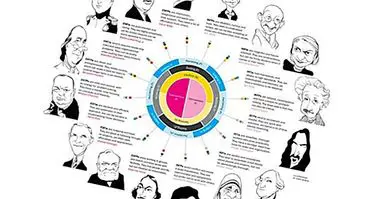The main theories of personality
Personality, understood as the relatively stable set of trends and thought patterns, information processing and behavior that each of us manifests throughout life and through time and different situations, is one of the main aspects that have been studied and analyzed by Psychology. Different currents and authors have established different theories and personality models.
Below we briefly explain some of the main theories of personality , which start from different approaches such as the internalist, the situationist and the interactionist or the correlational, the experimental or the clinical.
- Related article: "Differences between personality, temperament and character"
The most important personality theories of Psychology
These are the contributions to the study of personality that traditionally have had more weight throughout the history of Psychology. However, not all are still valid today.
1. Freud's theory of personality
The psychodynamic current has contributed various theories and personality models , being the best known those of the father of psychoanalysis, Sigmund Freud. For him, behavior and personality are linked to the existence of impulses that we need to put into practice and the conflict that this need implies and the limitation that reality implies for its fulfillment. It is a clinical and internalist model.
In his first topic, Freud proposed that the human psyche was structured in three systems , an unconscious one governed by the search of the reduction of tensions and works through the pleasure principle, a conscious one that is governed by the perception of the external world and the logic and the reality principle and a preconscious in which the unconscious contents can Become aware and vice versa.
In the second topic, Freud determines a second great structure of the personality compatible with the previous one, in which the psyche is configured by three psychic instances, the Id or Ello, the I and the Super-ego. The id is our most instinctive part, which governs and directs the internal energy in the form of impulses and from which all other structures start.
The "I" would be the result of the confrontation of impulses and impulses with reality , being a mediating structure and in continuous conflict that uses different mechanisms to sublimate or redirect the energies coming from impulses. Finally, the third instance is the superego or part of the personality that is given by society and whose main function is to judge and censure behaviors and desires that are not socially acceptable.
The personality is built up throughout the development, in different phases, based on the existing conflicts between the different instances and structures and the defense mechanisms applied to try to solve them.
2. Jung's personality theory
In addition to Freud, many other components of the psychodynamic current have proposed their own personality structures . For example, Carl Jung proposed that the personality was shaped by the person or part of our personality that serves to adapt to the environment and that is related to what others can observe and the shadow or the part in which those parts of the Self are included. that are not admissible for the subject.
Likewise, from the archetypes acquired by the collective unconscious and the different complexes that we adopt in our development towards identity, different types of personality are generated depending on whether the concerns are directed towards the interior or exterior, if they are more sensitive or intuitive and if they tend to focus more on thinking or feeling , being to think, feel, intuit and perceive the main psychological functions.
- Related article: "The 8 personality types according to Carl Gustav Jung"
3. The phenomenological theory of Carl Rogers
From a humanist-phenomenological perspective of clinical approach, Carl Rogers proposes that each person has his phenomenological field or way of seeing the world, depending on the behavior of that perception .
The personality is derived from the self-concept or symbolization of the experience of one's existence, which arises from the integration of the tendency to update or tendency to improve oneself with the needs of feeling love from the environment and self-esteem derived from the contrast between their behavior and the consideration or response that this receives by the environment. If there are contradictions, defensive measures will be used with which to hide said incongruity.
- Maybe you're interested: "The phenomenological theory of Carl Rogers"
4. Theory of Kelly's personal constructs
As example of personality theory derived from cognitivism and constructivism we can find the theory of Kelly's personal constructs, also clinical approach. For this author each person has their own mental representation of reality and acts in a scientific way trying to give an explanation to what surrounds them.
It is considered that the personality is constituted as a hierarchical system of dichotomous personal constructs They influence each other, which form a network with nuclear and peripheral elements through which we try to respond and make predictions of the future. What motivates the behavior and the creation of the system of constructs is the attempt to control the environment thanks to the prediction capacity derived from them and the improvement of said predictive model through experience.
- Related article: "The theory of the personal constructs of George Kelly"
5. Theory of ideographic personality of Allport
Allport considers that each individual is unique in the sense that it has an integration of the different characteristics different from the rest of people (it is based on the ideographic, in what makes us unique), as well as that We are active entities that focus on the achievement of goals .
It is one of the authors who considers the personality that works the personality from structural and stable elements, the features. For him, we try to make our behavior consistent and act in such a way that we create a system from which we can make different sets of stimuli equivalent, so that we can respond in a similar way to different stimulations.
Thus, we elaborate ways to act or express the behavior that allow us to adapt to the environment. These features have different importance depending on the influence they have on our behavior , being able to be cardinal, central or secondary.
The set of features would be integrated into the propium itself, which is derived from the self-perception and self-consciousness generated and composed of the experience of identity, perception, corporality, interests and self-esteem, rationality and intentionality.
6. Cattell's personality theory
The personality theory of Raymond Cattell is one of the most famous and recognized factorial theories of personality. Structuralist, correlational and internalist as Allport and starting from the analysis of the lexicon, considers that the personality can be understood as a function of a set of features, which are understood as the tendency to react in a certain way to reality .
These features can be divided into temperamental (the elements that tell us how to act), dynamic (the motivation of the behavior or attitude) or fitness (the skills of the subject to carry out the behavior).
The most relevant are temperamentals, of which Cattell would extract the sixteen primary factors of personality that are measured in the 16 PF (which would refer to affectivity, intelligence, stability of self, dominance, impulsiveness, daring, sensitivity, suspicion, conventionalism , imagination, cunning, rebellion, self-sufficiency, apprehension, self-control and tension).
The dynamics of the personality also depends on the motivation , finding different components in the form of dynamic traits or attitudes among which are ergos (way of acting upon specific stimulations such as sex or aggression) and feelings.
7. Eysenck's personality theory
From an internalist and factorial position centered on the biological, Eysenck generates one of the most important explanatory personality hypotheses from a correlational approach . This author generates the PEN model, which proposes that personality differences are based on biological elements that allow processes such as motivation or emotion.
The personality is a relatively stable structure of character, intellect, temperament and physique, each one providing the will, the intelligence, the emotion and the biological elements that allow them.
Eysenck finds and isolates three main factors in which all others can be grouped, being these the psychoticism or tendency to act with harshness, the neuroticism or emotional stability and the extraversion / introversion or focalization in the external or internal world.
The author would consider that the level of extraversion depended on the activation of the ascending reticular activation system or SARA, the neuroticism of the limbic system and psychoticism, although a clear correlate has not been identified, tends to be linked to the level of androgens or the relationship between dopamine and serotonin.
The three factors of the PEN model they integrate the different personality traits and allow the organism to react in certain ways to environmental stimulation based on more or less specific and frequent behavioral responses.
8. The Big Five theory of Costa and McCrae
Another of the great factorial theories and based on a lexical approach (based on the idea that the terms with which we explain our behavior allow after a factorial analysis to establish the existence of groupings of characteristics or personality traits), The Big Five or theory of the Big Five of Costa and McCrae is one of the most extended personality models .
Through factor analysis, this model indicates the existence of five major personality factors that we all have to a greater or lesser degree. Its about neuroticism or emotional adjustment , extraversion as quantity and intensity of personal relationships, cordiality as the qualities expressed in the interaction, responsibility or awareness, organization, control and motivation towards goals and openness to experience or interest in experimenting.
Each of these large factors is composed of features or facets. The different features are related to each other, and together they account for the way of perceiving the world and reacting to it.
9. The model BIS AND BAS of Gray
Gray proposes a factorial and biological model in which he considers that there are two dimensions that allow elements such as emotion and learning, based on the combination of the extraversion and neuroticism factors of Eysenck .
In this case, it is proposed that anxiety, as a combination of introversion and neuroticism, would act as a behavior inhibiting mechanism (BIS or Behavior Inhibition System), while impulsivity (which would be equivalent to a combination of extraversion and neuroticism) would act as a mechanism of approach and motivation to action (BAS or Behavior Approximation System). Both systems would act together to regulate our behavior.
10. Cloninger model
This model contemplates the existence of temperamental elements, being these the avoidance of pain, the reliance on reward, the search for novelties and persistence. These elements of biological and acquired nature would account for the behavioral pattern that we apply in our life, and depend to a large extent on the neurochemical balance of the brain in regard to neurotransmitters.
It also incorporates elements of character that help place one's self in reality, these being cooperation as social behavior, self-direction or autonomy and self-transcendence as an element that integrates us and gives us a role in the world.
11. Rotter's Theory of Social Learning
This author considers that the behavior pattern that we usually use is an element derived from learning and social interaction . It considers the human being an active element and uses a close approach to behaviorism. We act based on the existence of needs and the visualization and evaluation of these and the possible behaviors we have learned to carry out. Although close to interactionism, it is situated in a situationist perspective
The behavioral potential is the probability of performing certain behavior in a specific situation. This potential depends on elements such as expectations (both the ability to influence the results as well as the result itself and the possible benefits obtained after the conduct) and the consideration or value given to the consequences of carrying out the conduct in question, as well as the way in which the person process and assess the situation (known as psychological situation).
- Related article: "Rotter's theory of social learning"
12. The interactionist approach
Throughout history there have been many authors who have one of two positions: that the personality is something innate or that it is derived from learning. But nevertheless There is a third option, defended by authors such as Mischel , in which the personality is formed by the interaction between innate elements and the phenomena that we live.
This position explores personality characteristics through the study of the existence of consistency of behavior through situations, temporal stability and predictive validity of traits. The conclusions indicated that other types of different categorizations of features should be used , because these do not reflect a totally valid predictive model since they are of a more naturalistic nature. Defend that it is more efficient to talk about competencies, values, expectations, constructs and self-control.
Other authors such as Allen reflect that the consistency can vary according to the person, as well as the main values and the aspects that best predict the behavior. In this way, traits would be consistent but only if those that are most relevant to each person are taken into account.
Bibliographic references:
- Bermúdez, J. (2004). Psychology of the personality. Theory and research. (Vol I and II). Didactic Unit of the UNED. Madrid.
- Hermangómez, L. & Fernández, C. (2012). Psychology of Personality and Differential. CEDE Preparation Manual PIR, 07. CEDE: Madrid.



















